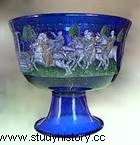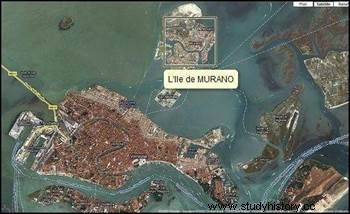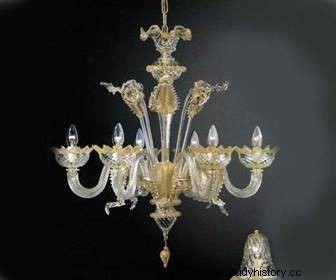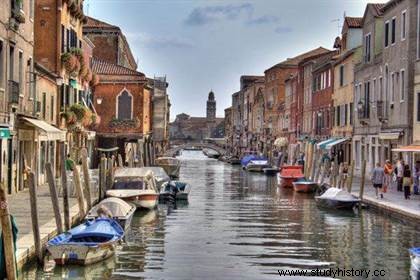 Besides the carnival of Venice, famous in part thanks to the superb masks, there are many other specialties representing the art in Italy, such as Murano Glass . Murano glass, materialized by cups, vases, mirrors, crockery which all European nobles were fond of, was used in the transactions of the countries at the time of the Serenissima. Traditional glassblowing began in Venice in the 13th century and became an important industry, which survives today thanks to the transmission of its techniques from father to son.
Besides the carnival of Venice, famous in part thanks to the superb masks, there are many other specialties representing the art in Italy, such as Murano Glass . Murano glass, materialized by cups, vases, mirrors, crockery which all European nobles were fond of, was used in the transactions of the countries at the time of the Serenissima. Traditional glassblowing began in Venice in the 13th century and became an important industry, which survives today thanks to the transmission of its techniques from father to son.
The story of the Master Glassmakers of Murano
The Egyptians introduced sodium carbonate, which mixed with sand and after fusion, gives a kind of glass paste, transported to the Mediterranean, then to Rome, Venice and Murano. The small island of Murano, about one square kilometer, located northeast of Venice, remains famous for its fine glass factories.
As early as the 8th century, there were glassmakers on this island. Most of them were installed in Venice, but in the face of numerous fires which led to disasters because the ovens were permanently lit and the dwellings were made of wood, the city authorities decided in 1201 to have the glassmakers moved to the island of Murano. The workshops set up on the small island, each master glassmaker jealously guarding the manufacturing secret and only passing it on to his son, the inhabitants became politically independent, a Grand Council was created, a mayor was appointed, the right to create a currency is assigned to them. Independent therefore, master glassmakers also hold a title of nobility and benefit from the privileges attached to it, being able to claim the highest offices in the Republic.
 Venice and its senate, not content to move the workshops, established strict regulations:obtaining a license for master glassmakers, defined number of workers to be employed by category, strict timetable for the operation of the furnaces, compulsory annual leave of five months between August and January!
Venice and its senate, not content to move the workshops, established strict regulations:obtaining a license for master glassmakers, defined number of workers to be employed by category, strict timetable for the operation of the furnaces, compulsory annual leave of five months between August and January!
Murano productions were highly appreciated in Europe, so much so that sovereigns made a detour to visit, admire and order their tableware. Of course, the European countries wanting to seize the know-how and the manufacturing processes, the Republic of Venice decrees then in 1275 the stop of the exports of raw glass and the materials composing it.
The greatest glass designers were the “Ballarins”. The first, the ancestor was Giorgio di Pietro, called Zorzi the Spalatino born in 1440. In 1456 he entered the service of Domenico Caner, glassmaker of Dalmatian origin, installed in Murano and worked wonders. The story goes that a workman once dropped a blowtorch on his foot, his gait becoming slightly lame, he was given the nickname “il ballarino” (the dancer). From 1479, all official documents mention a new family, the "Ballarino of Murano". In 1492, he produced transparent ruby-colored glass and became one of the richest producers on the island. He succeeded in buying properties, palaces, had a chapel built and died in 1506. Having become famous, in the midst of the Italian renaissance, he will remain in the memory of Murano…..
 Other glassmakers like Francesco Ballarin (1480-1555), Domenico Ballarin (1490-1570), Pietro Ballarin (1532-1599), are now considered true artists. Their notoriety spread beyond the Republic of Venice, in the Italian courts, beyond the Alps where their crystal cups adorned the tables of Francis I and that of Henry II. The Sultan of Constantinople was not left out, he also ordered a considerable number of sumptuous glass pieces. These vases, cups, stained glass were in the Imperial Court of Austria, in the Italian Duchies, in the palaces of Venice; the glass beads were also used for transactions in the city of the doges.
Other glassmakers like Francesco Ballarin (1480-1555), Domenico Ballarin (1490-1570), Pietro Ballarin (1532-1599), are now considered true artists. Their notoriety spread beyond the Republic of Venice, in the Italian courts, beyond the Alps where their crystal cups adorned the tables of Francis I and that of Henry II. The Sultan of Constantinople was not left out, he also ordered a considerable number of sumptuous glass pieces. These vases, cups, stained glass were in the Imperial Court of Austria, in the Italian Duchies, in the palaces of Venice; the glass beads were also used for transactions in the city of the doges.
The heyday of Murano glass
Between the 16th and 18th centuries, artists managed to color crystals, the production and fame of Murano glass was then at its peak, becoming a refined art that also offered the objects mentioned above, dishes, goblets, glasses, candelabra, mirrors, chandeliers and jewelry…. Everything went for the best until the Sun King, an artist at heart, loving all kinds of beauty, wanted to bring glassmakers to France, Colbert had the techniques spied on to bring them back to his Royal Manufacture of mirrors of Saint-Gobain, and…the Republic of Venice ended up having the deserting glassmakers who refused to return home killed!
But gradually the activity of Murano glass diminished, it was not until the 19th century that the attraction returned and after the Second World War, Murano's creations “woke up”.
However, of the three hundred factories from the beginning, unfortunately only about fifteen remain; from thirty-five thousand inhabitants in the fifteenth century, they have risen to five thousand today. From three hundred different colors in the heyday of Murano glass, only about sixty are used today. All these colors, all these objects, the evolution of techniques and styles can be appreciated and discovered at the Glass Museum of the Giustiniani Palace which exhibits a rare collection of four thousand pieces created since the beginning of the history of glassmakers.
 Today, fortunately these glassmakers are still present, but as the market evolves, objects are created on a larger scale quantity, certainly of high quality but whose style is more contemporary. The other side of the coin, tourists becoming more numerous and less spendthrift, producers produce “cheap” products….
Today, fortunately these glassmakers are still present, but as the market evolves, objects are created on a larger scale quantity, certainly of high quality but whose style is more contemporary. The other side of the coin, tourists becoming more numerous and less spendthrift, producers produce “cheap” products….
A popular island
The island of Murano is not only famous for its glassware, but also for its gardens. As we saw above, foreign princes came to admire the production. They could also walk in the gardens and found themselves among the artists, the poets like Pierre l'Arétin and the painters, who took advantage of the various perfumes and scents like jasmine and orange tree, as well as the sweetness of life in these places of pleasure.
The palaces were numerous there until the 18th century, the small houses of pleasure "the casins" are transformed into places of games of chance, from which comes the term " casino”. Casanova was recognized there...unfortunately these splendid residences were destroyed during the Italian campaign by Napoleon Bonaparte!
You can visit in Murano the Vetrario Museum (a museum of glassware), the Palazzo Giustiniani (including a fine collection of historical glass) as well as the Church of Santa Maria e Donata (founded in the 7th century and possessing remarkable Byzantine mosaics).
To go further
- Murano Glass Museum
- Murano Glass:From the Renaissance to the 21st Century. Gallimard, 2013.
- “the art of Murano glass” - Attilia Dorigato 2003.
